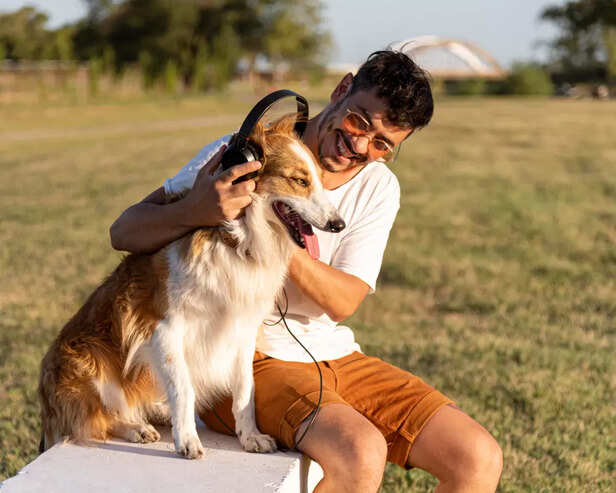Stop Yelling! Use These Stubborn Dog Breed Training Tips That Get Results Fast
Bindu Mishra | Apr 17, 2025, 23:59 IST
( Image credit : Times Pets )
Training stubborn dog breeds can be frustrating, but yelling isn't the answer. This article shares proven, gentle, and effective training techniques that actually work for even the most difficult dog breeds to train. Whether you’re dealing with a willful bulldog or a fiercely independent husky, these stubborn dog breed training tips will help you build trust, improve behavior, and see fast results—without stress or shouting.
Imagine this: you’re running late, your coffee’s cold, and your bulldog has decided to park himself in the middle of the hallway—again. You call, you beg, you even try bribing him with a treat, but he stares back at you like he owns the lease. Sound familiar?

If you’re a pet parent to a notoriously stubborn dog breed like a bulldog, beagle, dachshund, or husky, you’ve likely experienced the same exasperation. But here’s the hard truth—yelling doesn’t work. In fact, it often backfires.
Training stubborn dogs is not unlike trying to coach a strong-willed toddler through bedtime. You need strategy, patience, and emotional intelligence—not shouting matches. So, let’s flip the script and dive into dog training techniques that actually work—even for the most difficult dog breeds to train.
(Hint: It’s Not Just Attitude)

Before we jump into tips, let’s get one thing straight:
your dog isn’t being bad—they’re being independent. Some breeds were bred to make decisions on their own, like scent hounds or sled dogs. Others are just naturally curious, confident, or distracted by every squirrel on the street.
Think of it this way—would you respond well if someone tried to teach you something new by yelling? Probably not. Dogs are no different. They need clarity, calm, and consistency.

Training isn’t just about commands. It’s about connection. If your dog doesn’t trust you or finds you unpredictable (cue yelling), they’re unlikely to follow your lead.
What to do:
Spend time playing, cuddling, and just being with your dog. Take walks without training agendas. Let them associate you with safety, not stress. The stronger your bond, the more willing they’ll be to listen.
Image:

Let’s be real—we all work better when there’s a good reward involved. Your dog is no different. Stubborn breeds respond best when the payoff is worth the effort.
Pro tip:
Dry kibble won’t cut it. Use irresistible rewards like tiny bits of chicken, cheese, or store-bought training treats. The reward should match the level of distraction or challenge you’re working through.
3. Be Consistent—Like, Really Consistent
If you allow your dog on the couch on Mondays but not Fridays, you’re sending mixed signals. Stubborn dogs thrive on predictability. If they don’t get it, they’ll keep testing your limits.
What to do:
Set clear rules and make sure everyone in your home follows them. Use the same command words and the same tone every time. Repetition builds routine—and routine builds results.
Teaching a husky to heel or a dachshund to stop barking isn’t going to happen overnight. You wouldn’t expect a kid to master algebra before counting to ten, right?
What to do:
Start with bite-sized goals. Reward your dog for small progress. Celebrate a five-second sit before expecting a full minute. Stubborn dogs learn best in layers, not leaps.
Dogs live in the moment—literally. If you don’t reinforce or correct a behavior within five seconds, they won’t associate it with the action.
Example:
If your dog finally sits, but you fumble for a treat for 10 seconds, the moment’s gone. Keep treats in a pouch and praise instantly. Speed matters.
Stubborn dogs can trigger your inner volcano, but reacting emotionally only fuels their resistance. Just like kids test boundaries, dogs do too—it’s part of learning.
What to do:
If you feel frustrated, take a break. Step away and reset. Come back with a fresh mindset. Calm energy invites cooperation. Agitation shuts it down.
Punishing stubborn dogs (especially aggressive ones) with shouting, leash jerks, or isolation often escalates fear or defensiveness. It doesn’t teach them what to do—just what not to do.
What to do instead:
Redirect bad behavior. If your dog’s jumping, teach “sit” instead. Reward calm behavior. Guide them to better choices, just like you would a child learning boundaries.
Image:

Stubborn dogs are often smart—and bored. If training feels like a chore, they’ll tune out. But if it’s fun? Game on.
Try this:
Use hide-and-seek games for recall, or turn commands into mini agility challenges. The more fun they have, the more they’ll want to play (and learn) with you.
If your dog shows signs of aggression or deep-rooted behavioral issues, don’t go it alone. Hiring a professional trainer—especially one who understands positive reinforcement—can save you months of frustration.

The truth is, training stubborn dog breeds isn’t just about changing your dog’s behavior—it’s about shifting your own mindset. You’re not commanding a robot; you’re communicating with a living, emotional being who doesn’t speak your language. That requires empathy, clarity, and a whole lot of patience.
So, next time your pup ignores your “sit” for the fifth time, take a deep breath. Ditch the yelling. Grab that high-value treat. And remember: behind every stubborn dog is a chance to become a better, calmer human.
Training stubborn dogs? Yelling won’t work—but positive reinforcement, consistency, and clear communication will. Treat them with patience, train with strategy, and you’ll start seeing real results (and fewer standoffs in the hallway).
Discover expert advice and the latest tips on pet care, training, health, and more. Stay updated with all things pets at Times Pets!

Stubborn dog
( Image credit : Times Pets )
If you’re a pet parent to a notoriously stubborn dog breed like a bulldog, beagle, dachshund, or husky, you’ve likely experienced the same exasperation. But here’s the hard truth—yelling doesn’t work. In fact, it often backfires.
Training stubborn dogs is not unlike trying to coach a strong-willed toddler through bedtime. You need strategy, patience, and emotional intelligence—not shouting matches. So, let’s flip the script and dive into dog training techniques that actually work—even for the most difficult dog breeds to train.
Why Is Your Dog Stubborn?

Why your dog is stubborn
( Image credit : Times Pets )
Before we jump into tips, let’s get one thing straight:
your dog isn’t being bad—they’re being independent. Some breeds were bred to make decisions on their own, like scent hounds or sled dogs. Others are just naturally curious, confident, or distracted by every squirrel on the street.
Think of it this way—would you respond well if someone tried to teach you something new by yelling? Probably not. Dogs are no different. They need clarity, calm, and consistency.
1. Build a Bond First—Not a Battle

Create Good Connection
( Image credit : Times Pets )
Training isn’t just about commands. It’s about connection. If your dog doesn’t trust you or finds you unpredictable (cue yelling), they’re unlikely to follow your lead.
What to do:
Spend time playing, cuddling, and just being with your dog. Take walks without training agendas. Let them associate you with safety, not stress. The stronger your bond, the more willing they’ll be to listen.
2. Use High-Value Rewards (a.k.a. Bribes That Work)

Bribe your dog
( Image credit : Times Pets )
Let’s be real—we all work better when there’s a good reward involved. Your dog is no different. Stubborn breeds respond best when the payoff is worth the effort.
Pro tip:
Dry kibble won’t cut it. Use irresistible rewards like tiny bits of chicken, cheese, or store-bought training treats. The reward should match the level of distraction or challenge you’re working through.
3. Be Consistent—Like, Really Consistent
What to do:
Set clear rules and make sure everyone in your home follows them. Use the same command words and the same tone every time. Repetition builds routine—and routine builds results.
4. Break It Down—One Small Win at a Time
What to do:
Start with bite-sized goals. Reward your dog for small progress. Celebrate a five-second sit before expecting a full minute. Stubborn dogs learn best in layers, not leaps.
5. Try the 5-Second Rule
Example:
If your dog finally sits, but you fumble for a treat for 10 seconds, the moment’s gone. Keep treats in a pouch and praise instantly. Speed matters.
6. Stay Calm, Even When They Push Your Buttons
What to do:
If you feel frustrated, take a break. Step away and reset. Come back with a fresh mindset. Calm energy invites cooperation. Agitation shuts it down.
7. Avoid Punishment—Redirect Instead
What to do instead:
Redirect bad behavior. If your dog’s jumping, teach “sit” instead. Reward calm behavior. Guide them to better choices, just like you would a child learning boundaries.
8. Make Training a Game

Make Training a Game
( Image credit : Times Pets )
Stubborn dogs are often smart—and bored. If training feels like a chore, they’ll tune out. But if it’s fun? Game on.
Try this:
Use hide-and-seek games for recall, or turn commands into mini agility challenges. The more fun they have, the more they’ll want to play (and learn) with you.
9. Know When to Ask for Help
Train the Human First

Train the Human First
( Image credit : Times Pets )
The truth is, training stubborn dog breeds isn’t just about changing your dog’s behavior—it’s about shifting your own mindset. You’re not commanding a robot; you’re communicating with a living, emotional being who doesn’t speak your language. That requires empathy, clarity, and a whole lot of patience.
So, next time your pup ignores your “sit” for the fifth time, take a deep breath. Ditch the yelling. Grab that high-value treat. And remember: behind every stubborn dog is a chance to become a better, calmer human.
Training stubborn dogs? Yelling won’t work—but positive reinforcement, consistency, and clear communication will. Treat them with patience, train with strategy, and you’ll start seeing real results (and fewer standoffs in the hallway).
Discover expert advice and the latest tips on pet care, training, health, and more. Stay updated with all things pets at Times Pets!
Frequently Asked Questions ( FAQ's)-
- How do I get my dog to stop being stubborn?
Use consistent positive reinforcement, clear commands, and lots of patience to guide stubborn dogs effectively. - How do you train a stubborn aggressive dog?
Focus on calm, consistent training with professional guidance, using desensitization and rewards to reshape behavior. - What is the 5 second rule in dog training?
The 5-second rule refers to giving a reward or correction within five seconds of the behavior so your dog connects the two.
